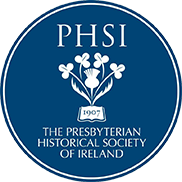From College to Parliament
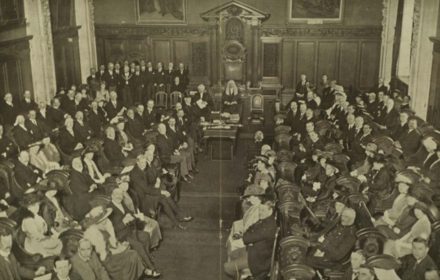 June 2021 marked the opening of the first Parliament of Northern Ireland which was created under the Government of Ireland Act, 1920, and following a general election on 24 May when Unionists won 40 seats, Nationalists 6, and Sinn Fein 6. The new regional legislature, consisting of a Senate and a House of Commons, first met in Belfast City Hall on 7 June 1921 until its adjournment on 23 June 1921. The inaugural meeting was presided over by the Lord Lieutenant of Ireland, Lord FitzAlan, and saw the election of Ministers to the Cabinet with Sir James Craig as Prime Minister and Hugh O’Neill as Speaker.
June 2021 marked the opening of the first Parliament of Northern Ireland which was created under the Government of Ireland Act, 1920, and following a general election on 24 May when Unionists won 40 seats, Nationalists 6, and Sinn Fein 6. The new regional legislature, consisting of a Senate and a House of Commons, first met in Belfast City Hall on 7 June 1921 until its adjournment on 23 June 1921. The inaugural meeting was presided over by the Lord Lieutenant of Ireland, Lord FitzAlan, and saw the election of Ministers to the Cabinet with Sir James Craig as Prime Minister and Hugh O’Neill as Speaker.
Official Opening of Parliament
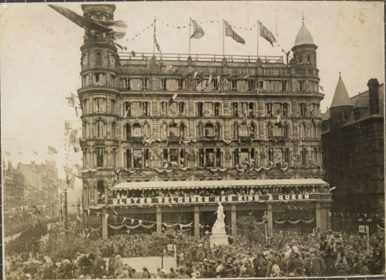 Amidst a grand fanfare of well-wishers in Belfast on 22 June 1921 and under strict security at a time when bombs, riots and murders were a regular occurrence, King George VI with Queen Mary came to Belfast City Hall to officially open the first Parliament. In his speech the King appealed "to all Irishmen to pause, to stretch out the hand of forbearance and conciliation, to forgive and forget and to join in making for the land they loved a new era of peace, contentment and goodwill", a sentiment which resonates with recent times.
Amidst a grand fanfare of well-wishers in Belfast on 22 June 1921 and under strict security at a time when bombs, riots and murders were a regular occurrence, King George VI with Queen Mary came to Belfast City Hall to officially open the first Parliament. In his speech the King appealed "to all Irishmen to pause, to stretch out the hand of forbearance and conciliation, to forgive and forget and to join in making for the land they loved a new era of peace, contentment and goodwill", a sentiment which resonates with recent times.
The first site of the Northern Ireland Parliament
Because the legislative site of the Parliament today is at Stormont one might assume that this is where the first Parliament met. However, Stormont was not opened until 16 November 1932 and shortly after the inaugural meeting in Belfast City Hall Parliament took up residence at what is now Union Theological College in Botanic Avenue, but then known as Assembly’s College.
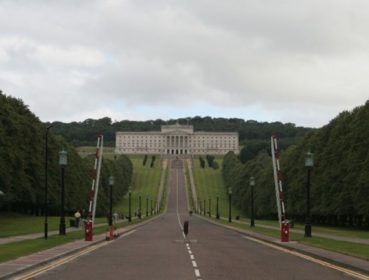
Before Parliament was opened preparations were already afoot to find a suitable temporary home for the new Parliament. Among the archives of Assembly’s College is a letter dated 2 May 2021 from James Craig to the Rev W J Lowe, Clerk of the General Assembly, enquiring if, following their inspection of Assembly’s College, the College could be made available as a temporary location for the new Parliament "during the three years or so as it was going to take to erect a permanent building". Interestingly, it took considerately more than 3 years before a permanent home was ready.


It would appear that rumours in English newspapers alleged that the work of the College was about to be transferred to another centre which prompted James Haire, the Secretary of the Faculty of College, to write in the Witness newspaper at the end of July 1921 that if the College buildings are leased to the Northern Ireland Parliament it would only be for a short period, that temporary premises would be provided in the same neighbourhood, that the work of the College would be carried on as usual and that this work would not suffer if the College buildings had to be surrendered for a short time.
There was also some concern that letting the College to Parliament might have a negative impact on the good relations with Magee College in Derry, the other Presbyterian theological training college but any fears were allayed when it was explained that the rent to be paid by Parliament would be sufficient to enable Assembly’s College to provide good premises for their students. By the end of August, property at University Square was purchased for classrooms and for a working library while property in College Gardens was rented for student accommodation.
It was agreed that £8,000 a year would be paid to the College for three years, that Parliament would indemnify the College Trustees against any damage to the premises by fire or civil commotion and that a bar would not be sanctioned. A list of the pictures, furnishings and fittings which the Parliament wished to retain as long as it occupied the building was drawn up and the items insured for £3,150. The final agreement was not signed until January 1922 although Parliament was already occupying the premises from August. The lease had to renewed twice – in 1924 and again in 1930 at the same rent.
By mid-September 1921 the work of transforming the College into a Parliament House was well under way with a large body of men engaged in carrying out the necessary alterations (central heating was installed and plumbing improved). Even as Parliament began its work on the 20 September work was still progressing on the upper floors as rooms were converted for the use of the Cabinet ministers, the Speakers of the Commons and Senate, the Whips and Sergeant-at-Arms. In those days there was no such ban on smoking as a large apartment was fitted up as a smoking room while the tea rooms were in close proximity to the two Chambers. However, the College Library and Chapel were "models of order and neatness" as the House of Commons met in the Gamble Library on green upholstered leather seats (the same as Westminster).
 The House of Commons in the Gamble Library
The House of Commons in the Gamble Library
Looking down on them were the portraits of Presbyterian worthies (Dr Samuel Hanna, the first Moderator of the General Assembly, Dr John Edgar and Dr Robert Watts, Professors of Theology, Dr Archibald Robinson, Professor of Sacred Rhetoric and Catechetics, Dr Matthew Leith Professor of Biblical Criticism and Dr James Heron and William Dool Killen, Professors of Church History).
The Senate met in the Chapel (described in the Belfast Newsletter as a room of elegant proportions) on crimson upholstered leather seats and where the new Parliament mace was exhibited.
 The Senate Chamber in the Chapel
The Senate Chamber in the Chapel
The Day of the Opening of Parliament
With the Union Jack flying over the College, the day of opening of Parliament had arrived on the 20 September – Speaker the Rt Hon Hugh O’Neill took the chair in the Commons at 2.15pm and in the Senate the Speaker, the Rt Hon Marquis of Dufferin and Ava took the chair. Security was tight – policemen were stationed at all of the doors of the College and no visitor was allowed to enter the building without a permit. Such was the demand from the public to acquire a permit that it proved impossible to grant all the applications. Interestingly, the Belfast Newsletter drew attention to the fact that many ladies attended the opening session and who must have experienced a feeling of pride at seeing two female elected representatives – Mrs Julia McMordie and Mrs Spencer Chichester – occupying seats in the Commons.
What happened to the College?
The pressure was on to find temporary premises for the College so on 25 July 1921 two of the Trustees – Professors Haire and Corkey were appointed to look at houses on University Square and College Gardens for classroom space and student accommodation. At a meeting of the Trustees on 9 August No 2 University Square had been purchased for £3,000 for classrooms, a study area and part of the Gamble library and before the end of August No 31 College Gardens was rented by the Trustees for student accommodation. A matron, cook and janitor were employed to look after these properties and provide meals for students and staff. The janitor was also used by Parliament to look after the College property and grounds throughout its occupation.
Return of Students and Staff to the College
Parliament didn’t vacate the College until 31 July 1932 with classes resuming in October 1932 although the Student Chambers were not available until January 1933 due to the extensive work required to renovate them. However, even a significant amount of renovation work had to be carried out before the training of students could resume. Planning for this began in Sept 1930 starting off with the drawing up of a list of tasks to restore and re-purpose the building under the supervision of three of the Trustees – John Williamson, John McCaughey and F J Holland. The Presbyterian firm of architects, Young & Mackenzie, were involved in the work while W H Stephens & Sons acted as quantity surveyors and A Drefus Ltd from London looked after the stonework which had deteriorated to such an extent that it was in a dangerous condition. The expenditure to renovate the interior, fix the heating, install electric lighting and purchase furnishings amounted to £16,000 with another £4,500 for restoring the stonework. The Government of Northern Ireland accepted a claim for compensation in respect of dilapidations and damage to College property during their occupation and paid £4,000 in settlement.
The College was officially re-opened on 27 October 1932 by Principal R S Rait, Vice-chancellor of Glasgow University who delivered the inaugural lecture.

There is very little physical evidence today that Assembly’s College was the original home of the Northern Ireland Parliament for 11 years apart from a commemorative plaque which hangs inside just above the main door of the College.
Permanent venue for the Northern Ireland Parliament
Various locations were investigated for a new permanent home for Parliament such as Belfast Castle and Belvoir Park but in September 1921 the choice of Stormont Castle on an elevated site on the outskirts of Belfast was voted on and approved by Parliament. One of the reasons Stormont was chosen was the space around it, 224 acres in total. The building itself is 365 feet wide, one foot for each day of the year – a home for every day of the year! It was officially opened on 16 November 1932 by Edward, Prince of Wales.
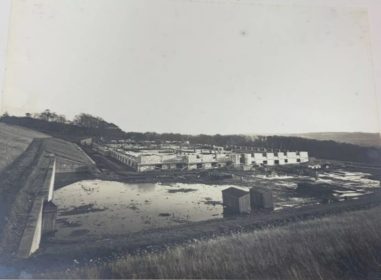 Stormont being built
Stormont being built
This article is based on an online exhibition written by Joy Conkey, Librarian of the Gamble Library, Union Theological College. It is an edited version of the full exhibition which can be seen at The Parliament of Northern Ireland and the College
The Presbyterian Historical Society is very grateful to Union Theological College for permission to place the edited version on this website.
Photographs of the letter from James Craig and the plaque above the front door of Assembly’s College are used with the permission of Union Theological College.
